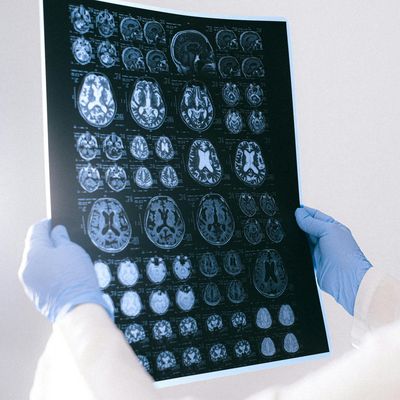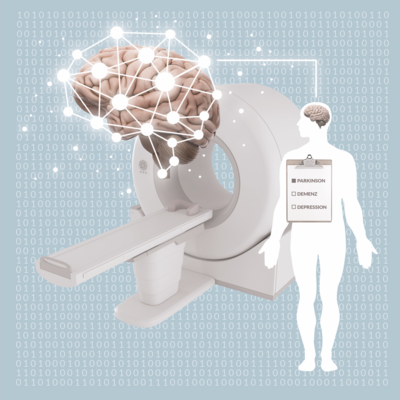Where the neurons are firing

Christian Gerloff completed his degree in electrical engineering. Now, he’s tracking down signals from one of the most mysterious and complex systems in existence. As a doctoral candidate at the HDS-LEE graduate school, Gerloff conducts research that unravels more hidden secrets of the human brain—thanks to data science methods.
Before Christian Gerloff even had the chance to experience an aha moment as he sat at his computer, his work started with people—at the University Hospital Aachen, for example—wearing strange, black hoods over their heads. Various cables, octodes, and sensors were attached to the hoods, and infrared light was directed through the test subjects’ scalps. The reflected light was measured in turn; specifically, while the test subjects were in varying states—such as playing computer games in pairs or simply relaxing.
By setting up these experiments, neuroscientists at the hospital want to use functional near-infrared spectroscopy (fNIRS) to determine which regions in the subjects’ brains are active in the respective states. This can be detected by the change in oxygen levels in the blood, which can be measured using the infrared light. When a region of the brain is active, the flow of blood to this area typically increases. The oxygen level in this location also rises as a result, and it can be presumed that a particularly high number of neurons fire in response. Researchers want to use the data from these measurements to draw conclusions.
And this, to put it briefly, is the point where Gerloff’s work starts. Gerloff is a doctoral candidate, and his thesis titled “Machine learning and Bayesian models in the neurosciences” aims at reliable insights into how the human brain is organized—with respect to basic research as well as subsequent therapeutic or clinical applications.
Enigmatic brain
“The brain,” Gerloff says, “is one of the most complex systems in existence.” But for scientists, it remains a black box in many ways. That’s why the young researcher is happy when he is able move a step forward in deciphering the links between individual areas of the human brain, or how different individuals’ brains behave in relation to one another as they interact.
Ultimately, these findings could be used to explore the correlation between social experiences and biological systems, such as whether there are characteristic neuronal states in which a mother and her child can respond to each other more effectively in emotional terms. Gerloff’s research is also a starting point for fields of clinical application, such as achieving a better understanding of the neurological conditions behind diseases such as ADHS or predicting cognitive impairments that strokes will cause in individual cases.
Advancing the neurosciences as an engineer
But Gerloff is not a neuroscientist—he is an engineer. He earned his master’s degree in electrical engineering from RWTH Aachen University. His thesis looked at how sensor data from modern vehicles can be used to predict when and what types of defects will occur in vehicle parts. During this time, Gerloff also worked on topics in various disciplines using machine and deep learning methods—in other words, with artificial neuronal networks that imitate the way the brain functions. This is how he came into contact with the neurosciences; the field captured his interest, and he decided to dig deeper.
What the blue-red data image reveals
Where does the blood go in the head?
The blue-red representation by Cologne-based designer Michael Schmitz is based on a data set from Christian Gerloff's research. It contains signals from 22 different sources from different brain regions of two participants. The data were collected simultaneously and provide information about the oxyhemoglobin concentration in the individual brain areas of the test subjects. Gerloff uses the data set to investigate where blood is sent in the brain, presumably because neurons in that area are more active during a mental task.
And this is exactly what made him a suitable candidate for the HDS-LEE graduate school in Jülich. The School for Data Science in Life, Earth and Energy was founded by Helmholtz in March 2019 and represents a partnership between RWTH, the University of Cologne, the German Aerospace Center, the Max Planck Institute for Iron Research, and Forschungszentrum Jülich.
HDS-LEE aims to encourage a disciplinary approach between the data sciences and natural sciences. The school has adopted this focus in response to the ever-increasing and increasingly complex data generated in most of the natural sciences. This requires experts who understand the questions addressed by the natural sciences and have the expertise that is needed to obtain the greatest possible insights from such data. To this end, HDS-LEE supports young, talented scientists in the fields of mathematics as well as the computer, natural, and engineering sciences who are driving the development of data science methods.
"The neural networks of our brain determine our cognitive abilities. At the same time, they are the origin of many methods in data science."
Christian Gerloff, doctoral researcher at HDS-LEE
Gerloff has been part of the first cohort at HDS-LEE since mid-2019. Roughly speaking, the approach behind his doctorate is to analyze the brain as a functional network—and to use data science methods to investigate exactly how it operates.
To do this, Gerloff applies methods from the field of machine learning—including algorithms and statistics as well as Bayesian models, which calculate the degree of probability—to process data from experiments or databases that are obtained, for example, using functional near-infrared spectroscopy (fNIRS) or functional magnetic resonance imaging (fMRI). A large part of his work consists of programming high-performance computers, as well as testing his implementations and methods. In addition, Gerloff continually works to improve his methodological understanding and refine the methods he uses to ensure that his studies will result in robust research findings.
The brain as source of inspiration and field of application
The young researcher is fascinated by his field and says, “The brain’s functions and its neuronal networks determine our cognitive capabilities. In other words, they define us to a certain extent. At the same time, they are the starting point for a wide range of methods in data sciences.” After all, these methods are inspired in part by the way the human brain processes information. “But at the same time, the brain and the data we now have on the brain are so complex that we need to improve our understanding of the methods and continually enhance modern methods so we can achieve better insights into the brain,” says Gerloff. “In this sense, the brain can serve as a source of inspiration and a field of application at the same time.” Which is why combining brain research and data science is a wonderful symbiosis.
“Exchange” is the magic word here. And this is exactly what HDS-LEE encourages with its interdisciplinary support. The professors supervising Gerloff’s thesis are Professor Kerstin Konrad, who heads the teaching and research area of childhood and adolescent clinical neuropsychology at University Hospital Aachen as well as an institute at Forschungszentrum Jülich; Professor Danilo Bzdok from McGill University and the Mila Quebec Artificial Intelligence Institute; and Raul Fidel Tempone, a professor of mathematics at RWTH Aachen.
“HDS-LEE also makes it possible to exchange ideas and information beyond our respective research fields, This can inspire different ways of approaching the problems in our own areas.”
Christian Gerloff, doctoral researcher at HDS-LEE
“HDS-LEE also makes it possible to exchange ideas and information beyond our respective research fields,” Gerloff says—and not just with his supervisors but also with doctoral candidates in other disciplines. “This gives us an insight into the other faculties and can also inspire a better understanding of the problems in our own areas or different ways of approaching them.” Different perspectives are key, and both sides benefit as a result. Doctoral researchers at HDS-LEE attend specialist lectures, seminars, and conferences together. “This means you’re not just working for yourself in your own little bubble,” says Gerloff. “Instead, you discuss both professional and personal matters with the other doctoral candidates.”
If you ask Gerloff whether he has had any aha moments in his research yet, he grins and says: “Yes, and the exact opposite, too!” He says that he’s sometimes been very happy when he has gained new insights into neuronal interconnections, but that he has sometimes also realized later on that his anticipation was premature, as some clue or another ultimately came to nothing. That’s the way research goes. You need to be willing to sit tight and have a certain tolerance for frustration. Gerloff appears to have these qualities. He is the type of person who thinks before he answers and, above all, doesn’t get ahead of himself. Gerloff has a warm personality and likes the fact that his research focuses on people first and foremost.
Author: Andrea Walter











